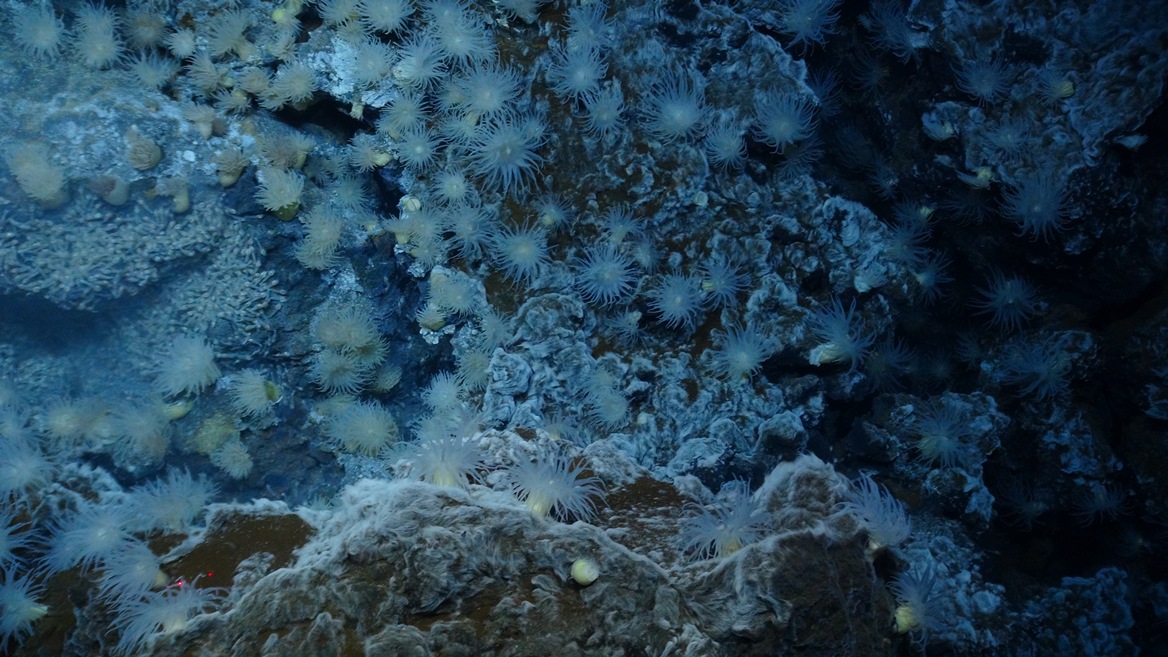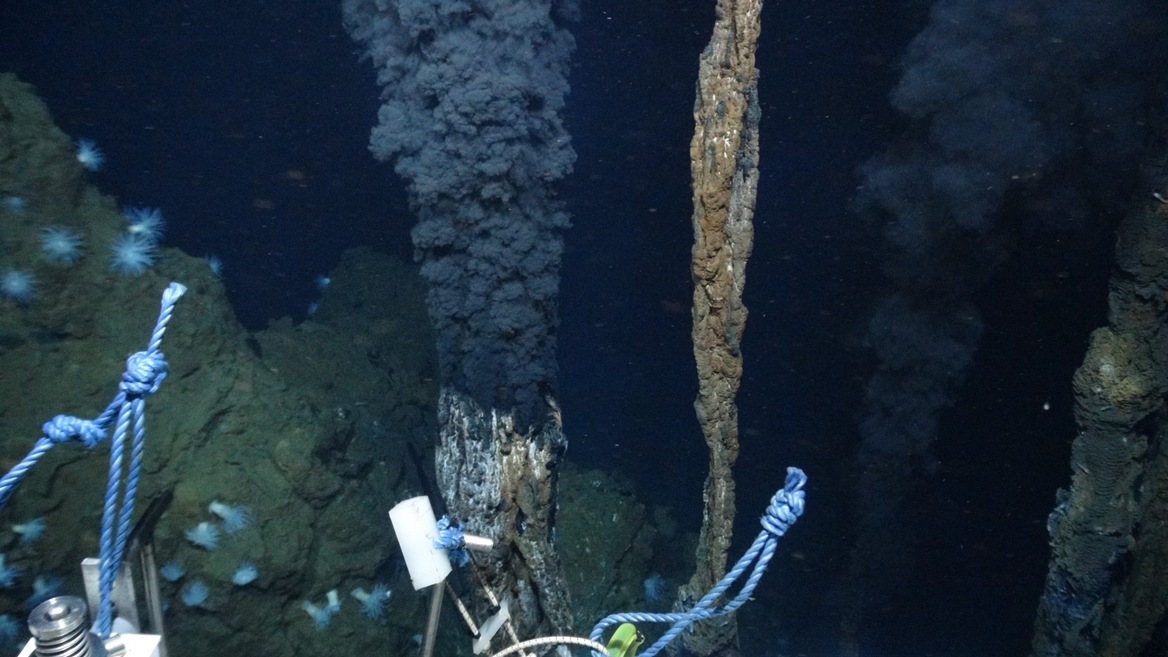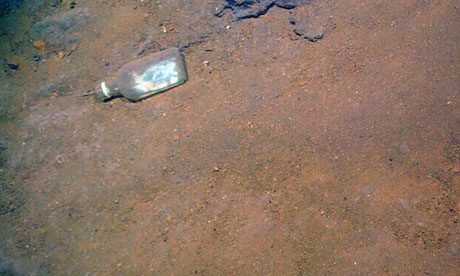 At 7 AM EST on Monday, February 25, the ROV Isis rose from the depths of the Cayman Abyss, bringing to a close the 82nd cruise of the RRS James Cook. During JC82, we explored two recently discovered hydrothermal vents fields in the Cayman Trough: Von Damm, named for the late marine geochemist Karen Von Damm, and Beebe, named for the 20th century explorer William Beebe. By any measure, JC82 was a massive success. The samples and videos we’ll bring back will provide ecologists, geologists, and chemists with new insights into fundamental ocean systems for years. The images alone, some beautiful, some heart-breaking, have already inspired.
At 7 AM EST on Monday, February 25, the ROV Isis rose from the depths of the Cayman Abyss, bringing to a close the 82nd cruise of the RRS James Cook. During JC82, we explored two recently discovered hydrothermal vents fields in the Cayman Trough: Von Damm, named for the late marine geochemist Karen Von Damm, and Beebe, named for the 20th century explorer William Beebe. By any measure, JC82 was a massive success. The samples and videos we’ll bring back will provide ecologists, geologists, and chemists with new insights into fundamental ocean systems for years. The images alone, some beautiful, some heart-breaking, have already inspired.

Since I last updated the blog on our adventures exploring the Cayman Trough, we’ve had a steady stream media coverage, most of which has been excellent, some of which has been… strange. It’s been fascinating watching the articles come out, seeing what different media outlets consider the story, and, most important to me, getting a chance to share our adventure with a wide audience. Now that the #DeepestVents cruise is officially over (and we’re in transit to yet another, equally exciting bolt on cruise to investigate submerged lava flows off the island of Montserrat), I thought it would be a good opportunity to reflect on the cruise, the story, and how the media shaped it.
Did you really discover the world’s deepest vents?
Technically, yes, but not really. We are working at the Beebe (or Piccard depending on naming priority) vent field, which, at ~5000 meters, is the deepest known hydrothermal vent field. Within this field are numerous chimneys, which are all part of the same geologic feature. What we found was a set of chimneys a few meters away and 10 meters deeper than another chimney cluster called Beebe 125. Because they’re all part of the same geologic formation, saying that we found the world’s deepest vents is a bit like saying that a SCUBA diver’s flippers are deeper than her head. Technically true, but not really informative. It’s likely that there are still chimneys around Beebe that are even a little deeper still, so we can all look forward to similar headlines from the next research cruise.
How did this all get started? As you probably know by now, we had a BBC crew come out to visit the ship for several days. At the moment when these new chimneys were discovered, David Shukman, who put together an outstanding package covering the cruise and the research we’re doing, was in the ROV van watching the discovery unfold. Because of the close proximity to Beebe 125, it took us a few moments to realize that we were looking at a new feature. As it slowly dawned on us that we had a different set of chimneys, the excitement built. Finding new chimneys is thrilling, no matter how deep they are, and having the opportunity to be among the first people to lay eyes on them is an awe inspiring moment. What is really captured in the breathless headlines about the world’s deepest vents is that visceral feeling of awe that hung heavy within the control van.
The new site, for the record, sits at 4965 meters depth and has been dubbed “Hashtag” in honor of the role twitter played in our public outreach.

What was up with all the trash?
The second most common topic raised by the media (and social media) concerned the trash we found on the sea floor. Our final tally stands at six pieces of garbage—a soda can, a beer bottle, a can and trash bag, a tin can, a rum bottle, and a roll of floor mats. To be honest, I’m actually surprised we didn’t find more. The Cayman Trough lies in the path of a major shipping lane that services the Panama Canal. We often saw massive Panamax container ships passing on the horizon.

The image of even a single piece of rubbish lying on the seafloor in one of the most remote places in the world is a powerful metaphor that is hard to ignore. Chief Scientist Jon Copley wrote an elegant piece in the Guardian about marine trash in the deep. The pictures we posted of seafloor trash were, by far, the most retweeted updates on twitter.
Speaking of twitter…
It’s pretty clear to all of us involved in the JC82 outreach effort that twitter is an ideal platform for expedition outreach. At sea, we have limited time and limited bandwidth, and twitter’s 140-character format made it easy to quickly update everyone when we have a few moments of down time. Combined with less frequent long-format blogging, we were able to run a very effective outreach campaign that was relatively painless.
You seem to have received a disproportionate amount of media coverage considering you were a last-minute addition to JC82?
In part, I think that my name shows up in a lot of articles because my contact info is easy to find. I received press inquiries through e-mail, facebook, twitter, google+, and through this blog (I also pitched a few to my internet colleagues). In almost all cases, I encouraged the journalists to contact the principle investigators, who actually wrote the grant for this cruise, and the graduate students, who do the lion’s share of the research. In many cases, particularly from US outlets, the resulting articles only mentioned me. I realize that journalists are on a tight deadline, which is why I provided them contact info for some of the more significant participants on the cruise. As I said in my last update, these cruises are massively collaborative, and one source is never going to have the whole story. In the future, I believe that I need to be much more insistent that other participants be contacted as well.
Andrew – I think many readers will agree that you are far too modest; I am sure that journos contacted you, quite rightly, because of your excellence in bringing the deep ocean alive to wider audiences, and I have been very grateful to have you and all your skills aboard on this trip!
The world’s fastest runner or swimmer is often determined by hundredths of a second. It totally counts that the vent your team found is the deepest.
Neat article. Reminds me of the Pulley Ridge expeditions in a way. Nice picture of the trash at 5000 meters. I was doing AUV work off the Bahamas in deepish water (1500-2000m) and the amount of debris on the bottom is unbelievable. The hand of man has touched everywhere on the planet or it would seem.